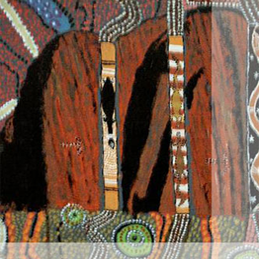

 There is not one but several native art traditions. To simplify: aboriginal art can be broken down into a number of stylistic regions, in each of which the artists share a common pool of visual techniques and vocabularies. For example, there is the art of Arnhem Land and the surrounding area, the Kimberleys (northwest coast), the desert (center) and the Cape York (northeast peninsula), but there is also the work produced by artists now living in urban areas. Just as religion, nature and art are inseparable, Aboriginal art takes many forms and serves more than one function: ancient rock art or ephemeral body paintings, paintings on the ground or sand sculptures, bark paintings, wood carvings, jewelry and plaiting. Art is thus regarded as a means of exchange between Aboriginal cultures and non-Aborigines ("Balandas"), where ideas and beliefs can be compared and contrasted. Art also plays a key role in the Aboriginal initiative to reclaim the rights and culture of indigenous peoples. Each Aboriginal group has its own stories and designs, which descendants of other spirits and other groups do not have the right to use. Certain sacred themes and designs are secret and are not supposed to be seen by those who have not been initiated or be used by outsiders. Although traditional Australian art dates back thousands of years, it is not frozen and intangible; it has proven itself to be open to new developments. Dreaming (or Dreamtime) The Dreaming is the time in creation when the creative forces and the ancestral beings traveled over the earth. The word is actually a mistake made by a researcher translating from the vernacular into English. In reality, contrary to the opposition between the dreaming and waking states, there is no formal separation between the dream world and the world of the living.
There is not one but several native art traditions. To simplify: aboriginal art can be broken down into a number of stylistic regions, in each of which the artists share a common pool of visual techniques and vocabularies. For example, there is the art of Arnhem Land and the surrounding area, the Kimberleys (northwest coast), the desert (center) and the Cape York (northeast peninsula), but there is also the work produced by artists now living in urban areas. Just as religion, nature and art are inseparable, Aboriginal art takes many forms and serves more than one function: ancient rock art or ephemeral body paintings, paintings on the ground or sand sculptures, bark paintings, wood carvings, jewelry and plaiting. Art is thus regarded as a means of exchange between Aboriginal cultures and non-Aborigines ("Balandas"), where ideas and beliefs can be compared and contrasted. Art also plays a key role in the Aboriginal initiative to reclaim the rights and culture of indigenous peoples. Each Aboriginal group has its own stories and designs, which descendants of other spirits and other groups do not have the right to use. Certain sacred themes and designs are secret and are not supposed to be seen by those who have not been initiated or be used by outsiders. Although traditional Australian art dates back thousands of years, it is not frozen and intangible; it has proven itself to be open to new developments. Dreaming (or Dreamtime) The Dreaming is the time in creation when the creative forces and the ancestral beings traveled over the earth. The word is actually a mistake made by a researcher translating from the vernacular into English. In reality, contrary to the opposition between the dreaming and waking states, there is no formal separation between the dream world and the world of the living.
